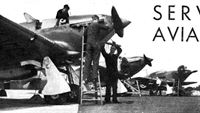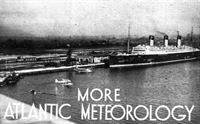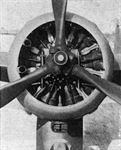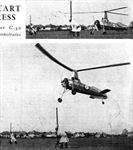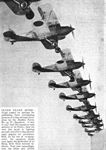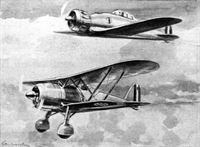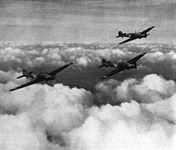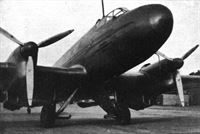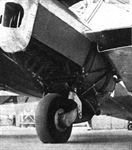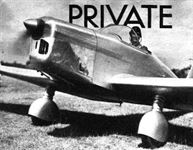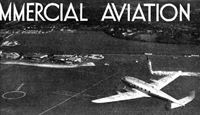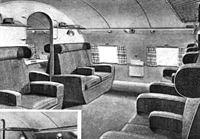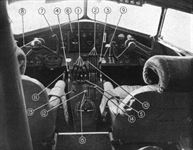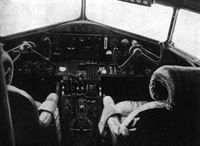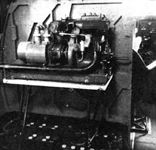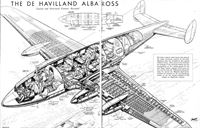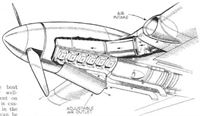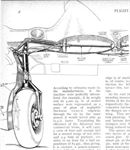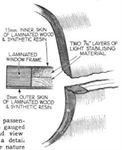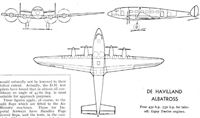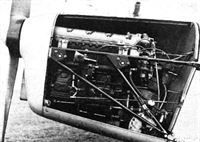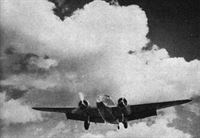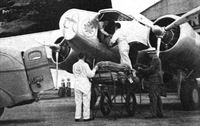Фотографии
-
Ministering to Hawker Hurricane eight-gun fighters of No.111 (F.) Squadron, Northolt.
Самолёты на фотографии: Hawker Hurricane - Великобритания - 1935
-
Регистрационный номер: G-ADHJ [2], G-ADHK [2] Самолёты на фотографии: Short Mayo Composite (S.20 Mercury and S.21 Maia) - Великобритания - 1938
-
Регистрационный номер: G-ADHJ [2], G-ADHK [2] The Short Mayo Composite lands at Heston! Otherwise a fine piece of model-making by Woodason Aircraft Models.
Самолёты на фотографии: Short Mayo Composite (S.20 Mercury and S.21 Maia) - Великобритания - 1938
-
Регистрационный номер: K7072 “LONG-NOSED BLENHEIM” is the somewhat inelegant though accurately descriptive nickname for this improved Bristol Blenheim bomber, which does 295 m.p.h. and has a cruising range of 1,900 miles. The engines are Mercury VIIIs and using 100-octane fuel for take-off. A machine of this type will be at the Paris Show, starting on November 25.
Самолёты на фотографии: Bristol Blenheim IV/Bolingbroke - Великобритания - 1937
-
HUNDRED OCTANE: One of the Bristol Mercury VIIIs in the 295 m.p.h. “long-nosed” Blenheim introduced in this issue. Take-off output, on 100-octane fuel, is 920 h.p.
Самолёты на фотографии: Bristol Blenheim IV/Bolingbroke - Великобритания - 1937
-
Самолёты на фотографии: Miles Magister / M.14 - Великобритания - 1937
-
Регистрационный номер: L7589 THE latest Cierva Autogiro - the C.40 - ordered for the Army and the Fleet Air Arm, shows its paces, piloted by Mr. Marsh. The two pictures were taken from the same viewpoint, the upper showing the machine in position ready for the jump-start. On the lower it is seen clearing the tape. The engine is a 170 h.p. Salmson. This is the first jump-start two-seater Autogiro. The experimental C.30, on which the early tests were made, carried a pilot only.
Самолёты на фотографии: Cierva C.40 - Великобритания - 1938
-
SEVEN YEARS AFTER: Flight makes no apology for publishing these outstanding pictures of a line-abreast formation by the Hawker Furies No. 43 (F.) Squadron. It was in 1931 that the squadron took delivery of its Furies, then the very last word in fighting aircraft, and still to-day exceedingly popular for aerobatics. Now, on the eve of re-equipment, the squadron shows once again the perfection of its flying with these beloved biplanes. Their new camouflage, with the white and yellow circles omitted, is of interest
Самолёты на фотографии: Hawker Fury - Великобритания - 1931
-
Самолёты на фотографии: Hawker Fury - Великобритания - 1931
-
TWO LINES OF FIGHTER DEVELOPMENT: The new Fiat biplane (below) is derived from the strong, manoeuvrable C.R.32 machine flown with such success in Spain. Above it is a new Macchi monoplane (fitted, like the biplane with a two-row Fiat with a maximum output of 840 h.p.) which, like all the new Italian fighter monoplanes, has been specially studied to provide good vision for the pilot.
Самолёты на фотографии: FIAT CR.42 Falco - Италия - 1938Macchi MC.200 Saetta - Италия - 1937
-
Регистрационный номер: L2673 A side view of one of the long-range Wellesleys showing that the fuselage is comparatively short in relation to the wing span. The special cowling and fairing arrangements may be noted.
Самолёты на фотографии: Vickers Wellesley - Великобритания - 1935
-
RECORD BREAKERS IN TRIPLICATE: The three Vickers Wellesley monoplanes (special Bristol Pegasus XXII) of the Long Range Development Flight which have added so much lustre to the name of the R.A.F. as a record-breaking service by eclipsing the world’s long-distance record.
Самолёты на фотографии: Vickers Wellesley - Великобритания - 1935
-
THE LONG-RANGE WELLESLEYS at Ismailia before their record flight.
Самолёты на фотографии: Vickers Wellesley - Великобритания - 1935
-
5-7 ноября 1938г.: два бомбардировщика Vickers Wellesley британских ВВС, пилотируемые сквадрон-лидером Р. Келлеттом и флайт-лейтенантом Э. Комбом, установили мировой рекорд дальности, пролетев 11520 км из Исмаилии (Египет) до аэропорта Росс-Смит (Австралия).
The personnel of the Long-Range Development Unit: (Standing, left to right), Sgt. J. H. Houghton, Flt. Lt. G. T. Gething,* Pilot Officer M. L. Gaine,* Sgt. H. B. Gray,* Sgt. T. D. Dixon,* Flt. Lt. B. K. Burnett,* Flt. Lt. R. G. Musson,* Flt. Lt. A. T. D. Sanders. (Sitting, left to right), Flt. Lt. A. N. Combe,* Sqn. Ldr. R. Kellett* (Flight Leader), Wing Cdr. O. R. Gayford, D.F.C., A.F.C. (Officer Commanding Long-Range Development Unit), Flt. Lt. H. A. V. Hogan,* Flt. Lt. P. H. Dunn. Asterisks denote those who took part in the actual flight.Самолёты на фотографии: Vickers Wellesley - Великобритания - 1935
-
WORKS FERRY: This diesel-engined Ju.86 seen at Croydon recently is the property of Junkers Flugzeugwerke and is used for customary business travels by the staff - and, in particular, by the managing director.
Самолёты на фотографии: Junkers Ju.86 - Германия - 1934
-
Самолёты на фотографии: Vickers Vildebeest / Type 132 - Великобритания - 1928
-
Flight testing was carried out on a D.H. 89. The “L” shaped fittings carrying the wheel arms were used to preserve the present location of wheel and vertical struts. Such fittings will not normally be required.
Самолёты на фотографии: De Havilland Dragon Rapide / Dominie / D.H.89 - Великобритания - 1934
-
Самолёты на фотографии: Tipsy B / BC - Бельгия - 1937
-
Регистрационный номер: G-AEVV The long-range D.H. Albatross, which will probably be the first machine to make serious use of both the Shannon Air Base and Collinstown, Dublin.
Самолёты на фотографии: De Havilland Albatross / D.H.91 - Великобритания - 1937
-
Регистрационный номер: G-AFDI READY FOR SERVICE: The first of Imperial Airways’ D.H. Albatross series, Frobisher, arrives over its future home. The type will be used mainly on the London-Zurich service, where its high cruising speed should be appreciated.
Самолёты на фотографии: De Havilland Albatross / D.H.91 - Великобритания - 1937
-
Two of the tanks for one of the long-range mail carriers acquired by the Air Ministry for trans-Atlantic work.
Самолёты на фотографии: De Havilland Albatross / D.H.91 - Великобритания - 1937
-
An artist’s impression of a cabin in the passenger-carrying version of the Albatross. Imperial Airways are having their own design of seat.
Самолёты на фотографии: De Havilland Albatross / D.H.91 - Великобритания - 1937
-
No excuse is offered for publishing another photograph of the Albatross control cabin - which is tidier than some and simpler than most. Below is a key to the more important controls and instruments.
1. Throttles. 2. C.S. airscrew controls. 3. Automatic pilot cut-out. 4. Landing light control. 5. Mixture and slow-running cut-out controls. 6. Sperry pilot panel. 7. Instrument flying group. 8. Brake lever. 9. Revolution counters. 10. Undercarriage switch and indicator. 11. Fore and aft trimming wheel. 12. Fore and aft trimming indicator. 13. Flap operating switch. 14. Flap indicator. 15. Rudder and aileron trimming cranks.Самолёты на фотографии: De Havilland Albatross / D.H.91 - Великобритания - 1937
-
The Marconi radio installation on the long-range mail carriers. On the left is an AD 67 A transmitter and on the right the receiver with medium/short wave homing equipment.
Самолёты на фотографии: De Havilland Albatross / D.H.91 - Великобритания - 1937
-
In comparison with the majority of modern control-cabin layouts in transport machines, that of the Albatross is extremely tidy. Most interesting, perhaps, is the layout of the engine and airscrew control bank, the flap and undercarriage operating gear and the trimming cranks. The undercarriage switch may be seen on the panel below that for the Sperry automatic pilot, while the flap switch and the rudder and aileron trimming cranks are arranged, with their appropriate indicators, below the engine and airscrew control levers. On the control bank are, left to right, landing light control, throttle and mixture, constant speed airscrew controls and automatic pilot cut-out. The fore and aft trimming wheel is on the left of the control bank. In the centre of the first pilot’s control half-spectacle will be seen the brake control lever, which is shown in the locked "on" position; when moved to the right the system is “free.”
Самолёты на фотографии: De Havilland Albatross / D.H.91 - Великобритания - 1937
-
The little Stanley motor used for emergency wireless operation. This is exclusive to the long-range mail-carriers for the Air Ministry.
Самолёты на фотографии: De Havilland Albatross / D.H.91 - Великобритания - 1937
-
Самолёты на фотографии: De Havilland Albatross / D.H.91 - Великобритания - 1937
-
A simple explanation of the cooling System employed for cooling the Gipsy Twelves on the Albatross. The air goes in the leading edge duct and is delivered to the engine from the rear, being exhausted through the adjustable outlet.
Самолёты на фотографии: De Havilland Albatross / D.H.91 - Великобритания - 1937
-
One half of the retractable undercarriage on a mail-carrying Albatross. When retracted the wheels are moved in the belly of the fuselage.
Самолёты на фотографии: De Havilland Albatross / D.H.91 - Великобритания - 1937
-
A makers’ representation of the speed efficiency of the Albatross in relation to its forerunner, the Comet racer. Particularly noteworthy is the reduction in engine drag.
Самолёты на фотографии: De Havilland Albatross / D.H.91 - Великобритания - 1937De Havilland Comet / D.H.88 - Великобритания - 1934
-
A detail sketch showing the nature of the fuselage construction.
Самолёты на фотографии: De Havilland Albatross / D.H.91 - Великобритания - 1937
-
DE HAVILLAND ALBATROSS Four 432 h.p. (530 h.p. for takeoff) Gipsy Twelve engines.
Самолёты на фотографии: De Havilland Albatross / D.H.91 - Великобритания - 1937
-
The Gipsy Minor as installed in one of the D.H. Moth Minors now flying at Hatfield. This view shows the formation of the front of the air-scoop.
Самолёты на фотографии: De Havilland Moth Minor / D.H.94 - Великобритания - 1937
-
MODERN FORMULA: There appears to be a tendency even in the U.S. to return to the high-wing layout which has always been favoured over here. This photograph of a model gives a good idea of the lines of the new D.H. 95 all-metal medium-capacity civil machine, which should be making its first test flights early next year.
Самолёты на фотографии: De Havilland Flamingo / D.H.95 - Великобритания - 1938
-
MOST OF MELBOURNE: The Percival Vega Gull which is used by the Shell Company of Australia, photographed when flying over the capital of Victoria. The distinctive colour scheme is interesting, though it makes a peculiar difference to the natural lines of the machine.
Самолёты на фотографии: Percival Vega Gull / K.1 - Великобритания - 1935
-
Регистрационный номер: NX18100 HALF-POWER: The Douglas D.C.4 flying on two engines; the other two have been stopped with the help of the full-feathering airscrews. In this form the D.C.4 has a ceiling of 11,000ft. on full load. Very shortly the machine will be taken over in turn by various American operators for service trials.
Самолёты на фотографии: Douglas DC-4E - США - 1938
-
TRANS-CANADA: Last month the Trans-Canada Air Lines service was officially extended to cover the section between Montreal and Winnipeg. In this set of pictures there are three views of one of the ten Lockheed Fourteens which are now, with five Electras, in service, and two pictures of typical Canadian terrain. Here, are the San Juan Islands near Vancouver
Самолёты на фотографии: Lockheed Super Electra 14 - США - 1937
-
A view of the Coast Range, near Seattle
Самолёты на фотографии: Lockheed Super Electra 14 - США - 1937
-
One of the T.C.A.L. Fourteens is shown coming in to land with the large-area Fowler flaps in the down position.
Самолёты на фотографии: Lockheed Super Electra 14 - США - 1937
-
Another scene at Winnipeg, with a Fourteen being refuelled. The transparent nose, enclosing the D/F loop, is an interesting feature. Without such an arrangement it would be necessary for this loop to be outside the fuselage, which is otherwise metal-covered.
Самолёты на фотографии: Lockheed Super Electra 14 - США - 1937
-
TRANS-CANADA: Last month the Trans-Canada Air Lines service was officially extended to cover the section between Montreal and Winnipeg. In this set of pictures there are three views of one of the ten Lockheed Fourteens which are now, with five Electras, in service, and two pictures of typical Canadian terrain. Here is a Fourteen taking on mails at the Winnipeg terminal.
Самолёты на фотографии: Lockheed Super Electra 14 - США - 1937
-
Marconi radio in a British Airways Lockheed Electra. On the left is the short-wave receiver, and on the right the medium-wave and D.F. receiver, with remote control for the external loop.
Самолёты на фотографии: Lockheed Super Electra 14 - США - 1937
-
PRIVATE PURSUIT: A 330 m.p.h. conveyance for yourself and a friend or two on 1,200 h.p. and a retractable tricycle. The Seversky Executive, a development project of the well-known military types. No sign of any cooling aperture for the Twin Wasp - unless it is designed with the nose-slot N.A.C.A. cowling.
Самолёты на фотографии: Seversky Executive - США - 1938
Статьи
- Flight
- Flight Advertisements
